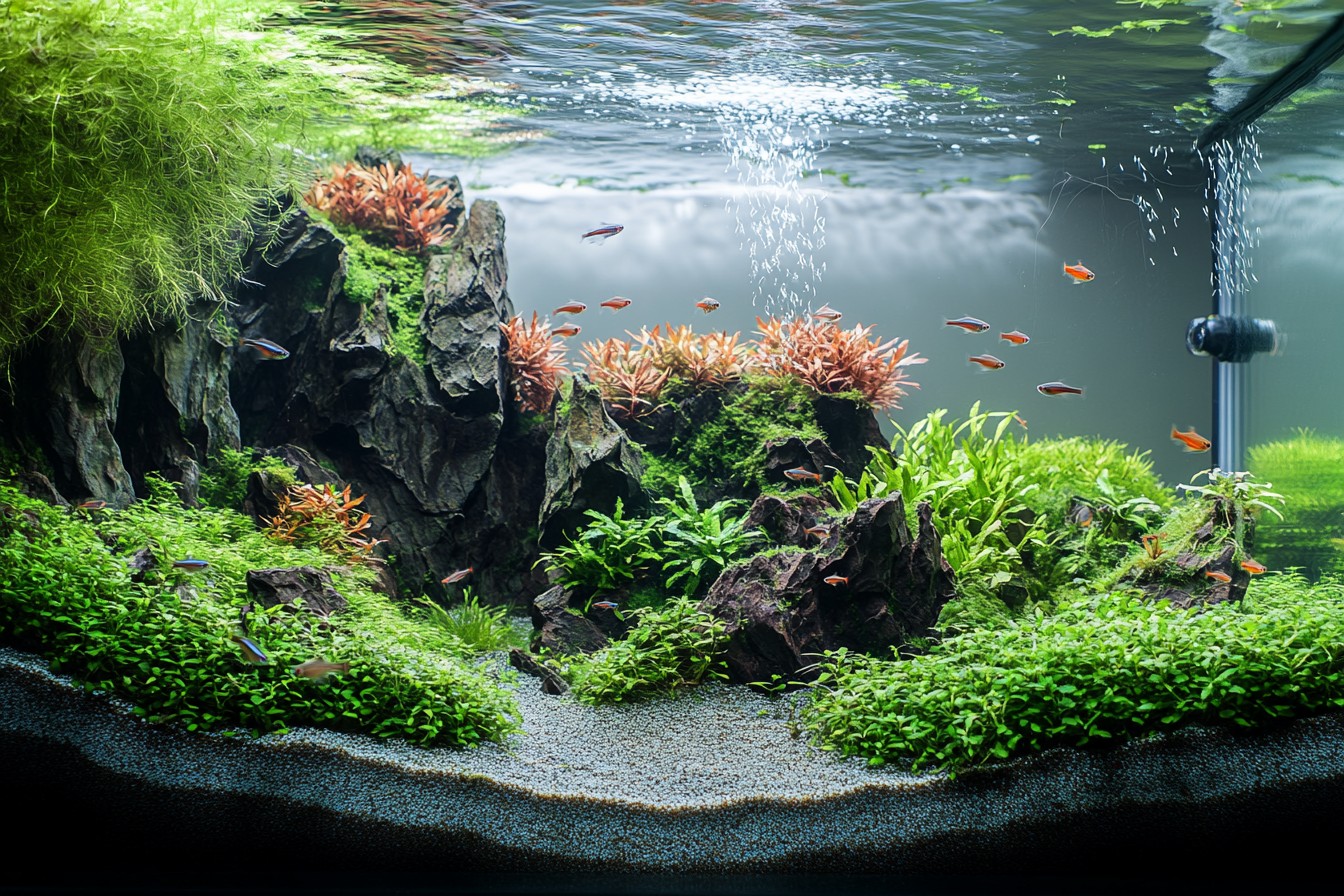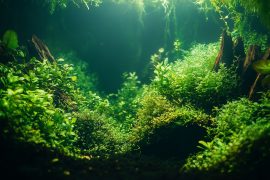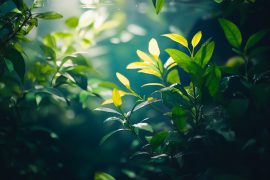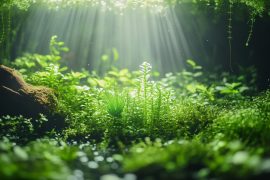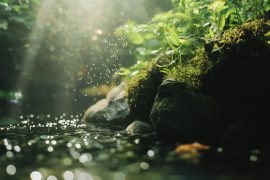Last Tuesday, around midnight, a message pinged on my phone. It was from a client I’d helped set up a massive 200-gallon planted discus tank the year before—a dentist with more money than free time who’d wanted an impressive aquascape but lacked the hours to maintain it properly. (I’d been back to his house four times since the initial setup, each visit increasingly resembling aquatic resuscitation rather than routine maintenance.)
“I’m downsizing,” his message read.
“Moving to a condo. Need something small but impressive for my office. Thinking 20×20 cube.
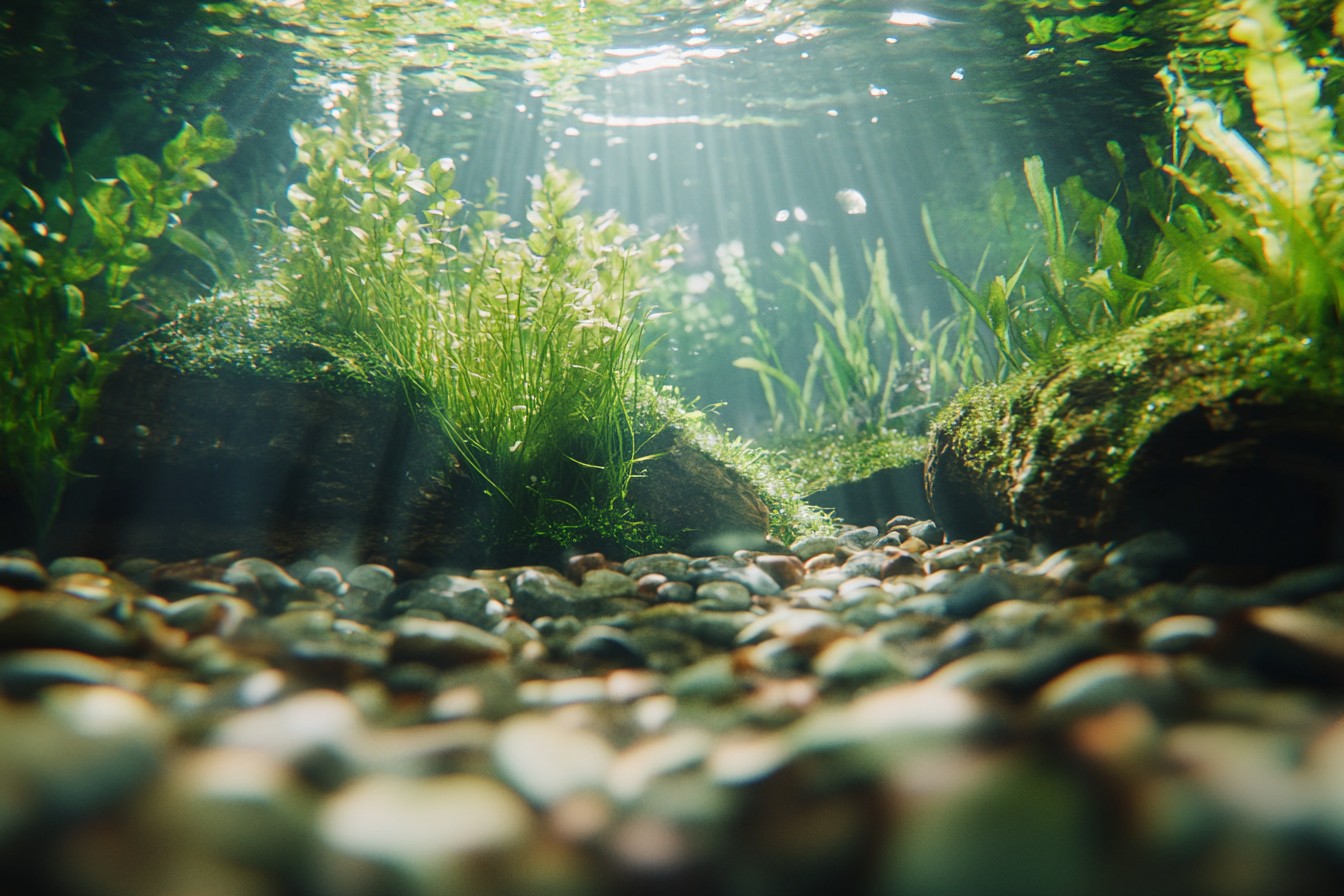
Can you make something amazing in that?”
I laughed out loud, startling my cat who gave me that particular look reserved for humans who make noise at inappropriate hours. The irony wasn’t lost on me. This guy had struggled to maintain a tank with massive water volume and stability, and now he wanted to go nano—where a half-cup of evaporation can shift parameters dramatically and a single dead leaf can trigger an algae bloom.
It’s like watching someone struggle to drive a forgiving SUV and then deciding to upgrade to a Formula 1 race car. But his question is one I get constantly these days. As urban living spaces shrink and the aesthetic of minimalism continues its cultural stranglehold, the demand for micro aquascapes has exploded.
Everyone wants a slice of underwater nature that fits on a desk or bookshelf. They’ve seen the Instagram-perfect nano tanks with their impossibly lush plants and crystal-clear water, not realizing those photos capture a fleeting moment that likely fell apart three days later. The truth?
Creating a truly impressive small-space aquascape isn’t just difficult—it’s a different skill set entirely from working with larger tanks. It’s like comparing epic novel writing to haiku poetry. Both tell stories, but the constraints of the smaller form demand absolute precision.
There’s no room for wasted elements, no forgiveness for proportional mistakes. When working with a 20×20 cube (about 17 gallons for those who think in water volume rather than dimensions), every single design decision becomes magnified. That perfectly twisted piece of spider wood that would look fantastic in a 40-gallon will overwhelm a nano tank, making it look cluttered rather than natural.
That striking red plant that adds a perfect accent in a larger setup will grow uncontrollably in a smaller one, requiring constant pruning to maintain the aesthetic. Scale becomes your obsession. I once spent three hours sifting through a 30-pound bag of seiryu stone looking for miniature pieces with the exact characteristics of their larger counterparts—the same striations, the same angular breaks, just…
smaller. My assistant found me surrounded by tiny stones arranged in precise piles, muttering about “proportional integrity.” She slowly backed away and canceled my afternoon appointments. For hardscape materials in nano tanks, I’ve found that branching spider wood or thin pieces of driftwood work beautifully as they create the impression of larger structures without consuming too much space.
For rocks, look for pieces with detail and character rather than size. Sometimes the most unassuming stone has fascinating texture when examined closely—and in a nano tank, viewers will be examining everything closely. Substrate depth is another critical consideration.
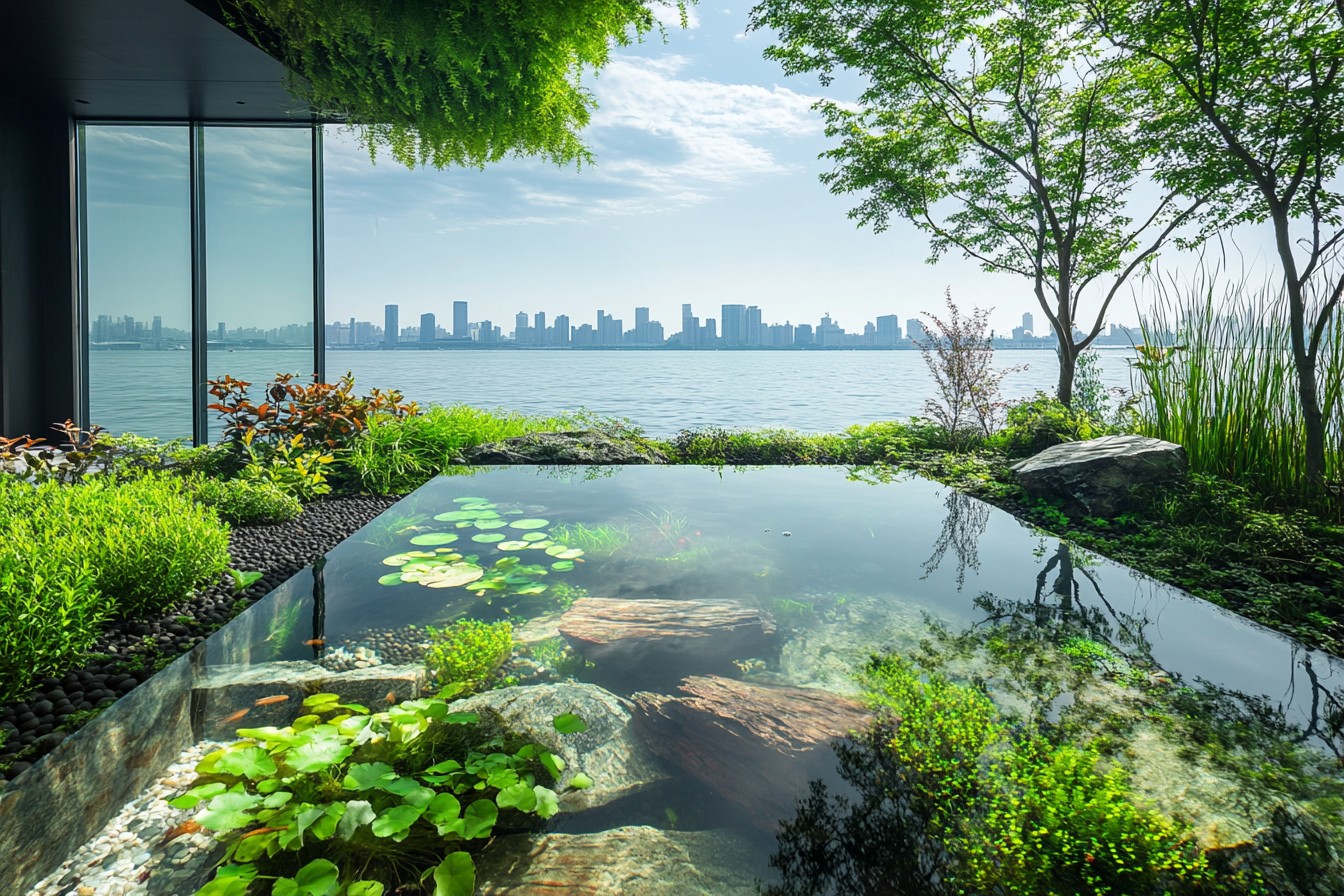
In larger aquascapes, I typically work with slopes ranging from 1-2 inches in the foreground to 4-5 inches in the background. In a 20×20, that same ratio would leave no water column. Instead, I create the illusion of depth by using finer substrate in the foreground and slightly coarser material in the background.
The textural difference reinforces the perspective shift without consuming valuable vertical space. Plant selection becomes a game of finding species that stay naturally small or can be easily maintained at small sizes. The classic carpet plants like Hemianthus callitrichoides ‘Cuba’ (HC) or Glossostigma elatinoides are obvious choices for the foreground, but even these can grow too thick in a nano setup.
I’ve had success with Utricularia graminifolia, which maintains a naturally lower profile. For midground texture, Anubias nana ‘Petite’ is unbeatable—it stays genuinely small and has a leaf size proportionate to mini landscapes. Background planting requires particular restraint.
Those gorgeous stem plants that create such striking backgrounds in larger tanks? They’ll quickly overrun a nano tank, requiring constant pruning and creating maintenance headaches. Instead, I favor slower-growing species like Bucephalandra varieties, which offer interesting leaf textures and colors without the rapid growth patterns.
The real secret to impressive nano tanks, though, is embracing negative space. Western aquascapers tend to fear emptiness, stuffing tanks with plants and hardscape until they resemble underwater jungles. Japanese aquascapers, meanwhile, understand that emptiness isn’t absence—it’s an active design element that gives the eye resting places and highlights the carefully selected focal points.
My response to the dentist included this advice, along with a suggestion that we integrate an iwagumi-style approach—using odd-numbered stone arrangements to create natural asymmetry in the confined space. His reply was a single question: “Can I keep discus in it?”
This, friends, is why aquascapers develop drinking problems. The filtration system for a nano tank presents its own challenges.
External canister filters, the workhorses of larger setups, are often overkill for small tanks, creating too much flow and taking up valuable external space. Internal filters consume in-tank real estate and ruin the carefully crafted aesthetic. My preferred solution is a small external hang-on-back filter modified with a surface skimmer attachment and glass lily pipes.
This provides necessary filtration while minimizing visual intrusion. CO2 injection—practically mandatory for lush plant growth in small tanks—needs to be precisely calculated. The standard working ratio of 30 ppm that works well in larger tanks can fluctuate dramatically in a nano setup where evaporation and plant consumption create rapid changes.
I use a dual-stage regulator with a needle valve that allows for extremely fine adjustments, accompanied by a drop checker positioned strategically to monitor CO2 levels throughout the day. Lighting presents another proportional puzzle. Nano tanks are shallower, meaning light penetrates more intensely.
The high-powered LED fixtures designed for larger tanks can quickly turn a nano aquascape into an algae farm. I often recommend fixtures specifically designed for small tanks, or using dimmable options that can be adjusted as the tank matures. Sometimes, counter-intuitively, I’ll use a slightly larger light fixture positioned higher above the tank to create more even spread without intensity hotspots.

Temperature stability is a persistent challenge in small-volume tanks. A 20×20 cube will heat up and cool down much more rapidly than larger systems, creating stress for livestock and potentially triggering algae issues. This is why I generally position nano tanks away from windows, heating/cooling vents, and other sources of temperature fluctuation.
In some cases, I’ve gone so far as to install small computer fans controlled by temperature sensors to maintain stability during hot weather. When it comes to stocking, restraint becomes the cardinal virtue. That dentist’s discus dream?
Absolutely not happening. In a 20×20, I recommend tiny schooling fish like chili rasboras or emerald dwarf rasboras, which stay under an inch in length and create the impression of a larger school in the confined space. A small group of nano shrimp not only adds visual interest but helps with tank maintenance, consuming algae and detritus that might otherwise accumulate.
The maintenance routine for a nano masterpiece differs from larger tanks. Rather than large weekly water changes, I recommend smaller, more frequent changes—sometimes as little as a cup of water daily, which is easily managed with a dedicated turkey baster kept alongside the tank. This prevents dramatic parameter shifts while still exporting waste products.
Pruning becomes a daily rather than weekly task, with trimming scissors kept within arm’s reach for quick adjustments. Despite all these challenges, there’s something magical about a perfectly executed nano tank. When all elements work in harmony, it creates an almost jewel-like intensity—a perfect miniature world that draws viewers in with its intimate scale.
I’ve watched people who walk past my 120-gallon island display with barely a glance spend minutes peering into a 12-inch cube, discovering new details and interactions with each passing moment. Which brings me back to the dentist. After explaining why discus were absolutely out of the question and providing a thorough outline of what a 20×20 setup would actually entail, I expected him to balk.
Instead, he surprised me. “That sounds perfect,” he wrote. “I want something that requires daily attention.
Something meditative. The big tank was meant to impress others—this one’s for me.”
And there it was—the perfect reason to embrace small-space aquascaping. Not as a compromise forced by spatial limitations, but as a deliberate choice to create something that requires presence, attention, and care.
Something that rewards close observation rather than casual glances. Something that exists at human scale, inviting interaction rather than just admiration. Six months later, that dentist’s 20×20 cube has become one of my favorite ongoing projects.
He sends me weekly photos documenting its evolution, along with detailed notes about his observations and adjustments. The tank contains exactly seven Boraras urophthalmoides (exceedingly tiny fish with bright red markings), a colony of blue bolt shrimp, and an aquascape built around three small pieces of driftwood arranged to resemble a miniature forest edge. It’s simple, elegant, and perfectly proportioned.
More importantly, it’s taught him what all great small aquascapes teach their keepers—that constraint breeds creativity, that details matter, and that sometimes the most impressive things come in the smallest packages. Just don’t try to put discus in them. I’m begging you.
